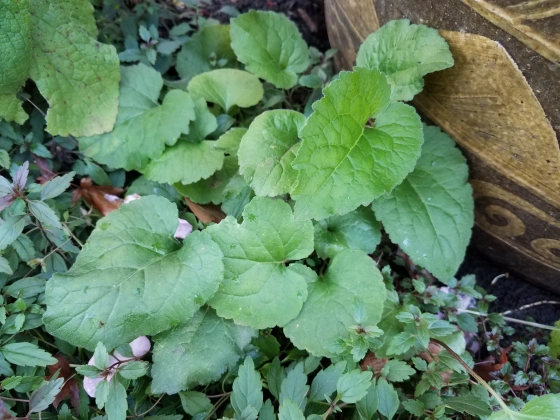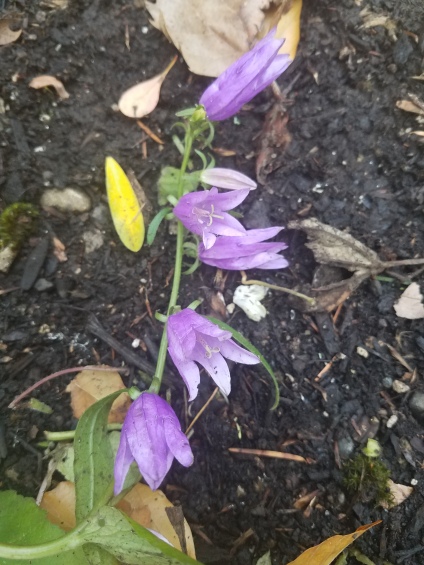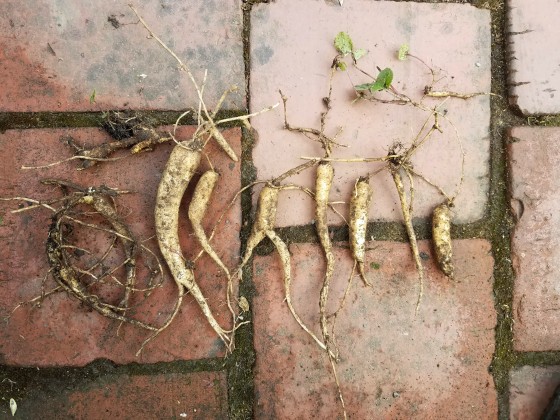Last week, I left you all with a cliff-hanger. What is this weed that I loath?

Campanula rapunculoides
This is Campanula rapunculoides aka creeping bellflower or rampion bellflower. It is native to Europe and Eurasia and was brought here as an ornamental garden plant. However, it quickly takes over a garden and makes it look messy and weedy. Over time, it will choke out favorite plants.

Flowers
Like the Arum that I wrote about last week, C. rapunculoides has underground root structures that make it difficult to eradicate. Pulling the leaves will not remove the roots. A few surface roots will come up but, little do you know, 6 inches to a foot below the surface lurk large, fleshy, white tuber-like roots that hold energy to regenerate the plant.

Roots with top growth and leaves
To get rid of the plant, you must remove all of the underground root structures. C. rapunculoides is resistant to some herbicides. Other herbicides must be applied more than once to fully kill the plants. In a garden setting, where C. rapunculoides likes to grow inside your perennial, it can be very difficult to apply an herbicide effectively.
Digging it out seems to be the only way to remove it in a garden. I have resorted to digging up perennials–like the peony in the photo above–and sorting out the roots before replanting. Undoubtedly, I have missed a few roots and constant vigilance is demanded to prevent it from taking over again.

Hiding in the Phlox at Deepwood
When it is impossible to dig out the roots, like when it is growing in a boxwood hedge, the top growth can be pulled or an herbicide dabbed on. If the leaves and stems are removed as soon as they appear, eventually the roots will be depleted of energy and die. Always read the label of herbicides and do some basic research before applying to make sure that C. rapunculoides is susceptible and that conditions are favorable for the most impact. Remove all flowers before they spread their thousands of seeds to the wind.

Growing in a calla lily
I want to stress that this plant is not classified as invasive in Oregon. However, it is an nuisance in the garden and one of the plants I am working hardest to eradicate. It is listed as invasive in other states.
I also want to point out that not all Campanula are evil. Lord & Schryver loved their Campanula medium, Canterbury bells, and so do I. They are lovely annual or biennial plants that die after flowering. They have no fleshy underground roots or runners to carry them to other places in your garden. There are many other Campanula species and cultivars sold in the nursery trade. Below are three different kinds of Campanula we grow at Gaiety Hollow and Deepwood.
Next week, we’ll cover one more weed. It might be called “the scourge of Gaiety Hollow.” Can you guess what it is?







only a guess—Bishop’s weed? some migrated to our yard under the fence and immediately began boisterously colonizing. we had a Devil of a time getting rid of it.
Right you are! Aegopodium podagraria. It’s horrid stuff.
As an aside–I saw your show at the Hallie Ford Museum of Art and was inspired. I love your work.
Thank you so much! I’m sorry that I didn’t get to this earlier. That show will probably be the pinnacle of our “career” since we really aren’t career artists.
I think its relative is invading my yard:
I think this is Campanula punctata, Spotted Bellflower
Very invested root system but I have not seen tubers. Fortunately it is just in one corner of my front yard but it will be with me for a while! I spent many hours this year and last digging out what I could.
Thanks for the weed tutorials, especially the photos!
Karen
>
It looks like C. punctata is considered an introduced species in Connecticut and New Hampshire, so it wouldn’t surprise me that it is a thug in your garden. If I remember correctly, it was a problem in the gardens I worked in in Michigan.